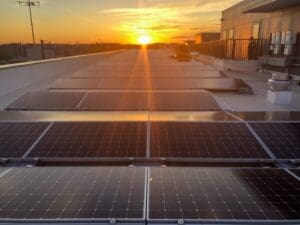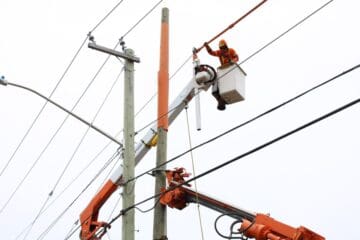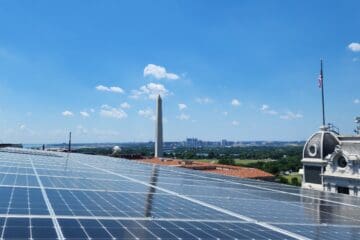Maryland Community Solar is a significant step towards making renewable energy accessible to a broader range of residents and businesses, fostering a more inclusive and sustainable energy future. Maryland Community Solar is a program designed to expand access to solar energy for residents and businesses who may not have the ability to install solar panels on their own properties. This initiative aims to make solar energy more inclusive, allowing individuals to participate in solar projects and benefit from renewable energy without requiring direct installation. In April 2023, the Maryland state legislature passed House Bill 908, creating the Community Solar Energy Generating Systsems Program and making it permanent after a seven year pilot program.
One of our ground-mounted installation in Maryland
How does the Inflation reduction Act affect Community Solar?
The Inflation Reduction Act Factor
Some of the most aggressive renewable energy incentives in the new Inflation Reduction Act involve community solar projects- making them more affordable, economical and accessible. Th incentives include the baseline ITC- 30% tax credit (That goes for ANY solar installation). An added 10% tax credit for systems under 5 MW that serves low-income subscribers, a 10% credit for systems sited in former fossil fuel communities, and up to 20% credit for systems that serve at least 50%+ qualified LMI households.
This all sounds amazing- so why aren’t there community solar arrays on every unused piece of land in the state? First off, the project needs to be sited in an area where the grid can take the increased amount of produced energy. The old model of dirty coal plants as a centralized generation feeding out to transmission lines trickled to the more rural or open areas with smaller transmission lines since there is usually little density in those rural areas. Distributed generation (decentralized generation that allows for multiple producers throughout the grid) needs the transmission lines from that generated energy production to be able to handle that new energy. It’s been an ongoing caveat since PV really took off within the past 15 or so years as to where to site solar so that the transmission lines could handle it, and take on the added capacity.
Read Also:
One of our farm installations in Virginia
What are the constraints of Community Solar and Land Use?
Maryland-Specific Constraints are Centered Around Utility Participation & Land Use
As far as the Maryland community solar program goes, land use and voluntary utility opt-out has cropped up as being major constraints as to where these systems can be installed (as discussed in Solar United Neighbors Community Solar in Maryland Year Two Report) . Let’s start with SMECO (the Southern Maryland Electric Cooperative). A few months after the initial program was established in 2016, SMECO and Choptank Electric Cooperative filed a petition with FERC (Federal Energy Regulatory Commission) asking the commission to review whether the community solar program in Maryland complied with federal law. By November of that year, the petition was dismissed by FERC.
SMECO then applied to join the community solar program, and submitted a tariff for consideration to the Maryland Commission, requesting a change in regulation for program energy credits applied for community solar customers. (This change only would have applied to community solar subscribers in the SMECO service area). That tariff request was rejected by the Commission. SMECO then attempted to escalate the request to FERC, which was also denied.
According to the State of MD website (at the time of this writing) SMECO is not currently a part of the community solar program, effectively taking southern Maryland out of the running for community solar.
Getting ready for a field install in Maryland
Zoning Decisions
There are also several counties across the state that have severely limited ground-mounted solar arrays by either flat-out restricting or limiting these ground-mounted solar to the point that community solar is not possible in the county generally. Anne Arundel and Baltimore Counties are unfortunately prime examples of this. Cross-reference that with the smaller municipal systems and rural cooperatives that have opted not to participate in the community solar program, and the map for project placement dwindles. The good news is that Howard, Prince George’s and Montgomery Counties are within either the BG&E or PEPCO service areas and all allow community solar projects (even on agricultural land). They also happen to be some of the most populated counties in the state, placing community solar generation close to population density- and more importantly, within the realm of the subscribers. (Community solar projects and subscribers must both be in the same utility service area).
In short, community solar is a much-needed tool that can bring the state into the clean energy era by providing solar as an option to any ratepayer in the state. As the aftereffects of the Inflation Reduction Act continue to reverberate and fast track renewable energy deployment, hopefully the community solar siting possibilities within Maryland will open up according to consumer demand rather than directive defiance.
Does Aurora Energy install community solar? As a matter of fact we do. Give us a call or submit a form, and we can get you started.






